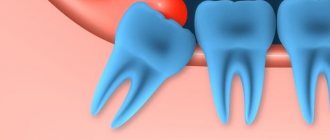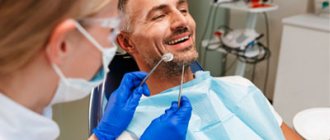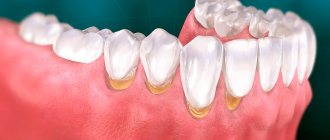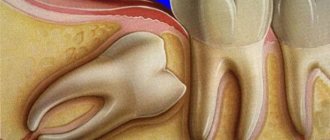There are several common reasons why a tooth hurts under a crown.
Causes of pain
As a rule, before installing a crown, the tooth is depulped - that is, the neurovascular bundle in the root and coronal part is removed, after which the canals are filled. Pain may be caused by some features of these manipulations:
- incomplete filling of the canals - as a result of the formation of voids in the root canals, an infectious process may begin to develop; Pus accumulates at the root tip, which causes pain. This is a common complication of endodontic treatment, especially in cases where the canals are too narrow or curved;
- subsidence of filling materials over time - even if the root canals are completely filled, changes in the physical properties of the materials can also lead to the appearance of voids - infection develops in them, inflammation spreads to the tissues near the apex of the tooth root;
- removal of the filling material beyond the root apex - “excess” material in the periodontal tissues can provoke irritation and inflammation.
Pulpitis. Inflammation of the pulp can occur in cases where a decision was made to preserve it - tooth processing can lead to a burn, the infectious process may already begin in the pulp and be asymptomatic, which becomes the cause of inflammation. Preserving living pulp before installing a crown on a tooth is a rare occurrence; as a rule, the “nerve” must be removed.
Perforation of the walls of the root canal. Perforation is the creation of a hole in the root canal, a phenomenon that occurs for several reasons:
- perforation may be a consequence of mechanical processing of the canal with a thin instrument - it must enter the canal along its entire length. If the canal is curved, then even a slight pressure can cause the instrument to pass through the tooth tissue;
- installation of a pin can lead to perforation - it is installed in the root canal, which, given the appropriate anatomical features of the structure of the root system, can also lead to the formation of a hole.
The hole is a “gateway” for infection—the tissue becomes inflamed some time after the pin is installed or endodontic treatment is performed, which causes pain.
Why does the tooth under the crown hurt?
The reason for this may be the presence of a foreign body in the canal. During endodontic treatment, the tip of the instrument may break off; subsequent filling of the canal with a foreign body leads to pain. There can be several reasons for breakage - the most common of them is the curvature of the canals. If they are difficult to pass, the tool may break due to the high load.
As a rule, in this case, the patient feels pain when exposed to temperatures, and the tooth under the crown also hurts when pressed. Pulsation may appear during exertion or chewing on the side with the crown installed. Tapping on a tooth also causes discomfort.
In order to avoid such a complication, the dentist must perform an x-ray diagnosis before installing a crown or any other dental prosthesis.
If the technology for processing and preparing the tooth for prosthetics is followed, installing a crown can also cause pain - if the design is too high for the bite, the patient feels discomfort when closing the jaws. This is why the stage of “trying on” the crown before its final installation is important - a good orthopedic dentist will first assess the degree of comfort for the patient.
Treatment of pathology
Lateral flap
Using this method, it is possible to lift the gums. But it is rarely used due to the fact that healthy tissue has to be displaced onto damaged areas. This defect affects almost the entire jaw, so it is difficult to apply a lateral flap.
The positive quality of this method is the instant result. If all preventive standards are followed, the risk of relapse is minimized.
Collagen membrane
It is placed on the cortical plate of the alveolar process for tissue regeneration. When its functions are restored, it will be deleted. Although some dentists use absorbable materials that dissolve on their own after a certain period of time. But they just cost more. Due to the membrane, approximately 80% of tissues are restored.
A pulpless tooth hurts
If the pulp has been removed, the pain is most often aching. It can radiate to the temple or ear. The main reason for this phenomenon is the exacerbation of chronic periodontitis. The choice of therapy method is determined by the presence or absence of a pin in the tooth root canal:
- there is no pin: the doctor opens the crown, unseals the root canals and treats them properly, after which he places materials impregnated with antibacterial agents into the tooth. Several changes to the medication may be required until complete relief is obtained and the inflammatory process is eliminated. After the symptoms have completely subsided, the canals are filled again and a new crown is installed;
- there is a pin: the doctor can cure periodontitis through surgery - resection of the apex of the tooth root. It is performed through a small incision in the gum, through which the source of infection is removed, and if necessary, the resulting void is filled with osteoplastic material. Typically, the intervention lasts from 30 to 60 minutes and is well tolerated by patients.
Surgery
If drug therapy does not produce the desired results, then the gums at the bottom of the tooth can be lowered using surgical intervention. This will restore the level of the gums, covering the exposed roots of the tooth. For these purposes, soft tissues are transplanted from the upper palate or moved from nearby areas, provided they are of sufficient volume.
If tissue is removed from the upper palate during the operation, scars may form at the site where it is planted. This will reduce aesthetics, so it is better to use the option of moving the fabric from a nearby area.
Gum pain
If the gums hurt, and not the tooth itself with a crown installed, there may be a deformation of the crown or a discrepancy in its size - the gums are mechanically damaged, which leads to inflammation and pain. For example, the edge of the crown extends under the gum or, on the contrary, does not reach its edge significantly - in the first case, a sharp edge can lead to soft tissue injury and inflammation. Moreover, it is worth noting that the pain can radiate into the tooth itself, which makes self-diagnosis difficult - the patient simply does not understand that it is the gums that hurt, and not the tooth under the crown.
If the crown does not reach the edge of the gum, the tooth under the crown hurts greatly - but not immediately after installation, but after quite a long time. The retention of food debris between the edge of the structure and the gum leads to the proliferation of pathogenic bacteria, the development of caries, and the destruction of tooth tissue under the crown. This leads to severe pain, tooth reactions to temperature, stress, etc.
The doctor’s tactics in this case is to remove the unsuitable crown; this is the only measure that a specialist can take to eliminate the problem.
If the gums are swollen, and even more so in cases where there is swelling of the cheek, there is most likely inflammation in the area of the apex of the tooth root. As a rule, swelling forms in the projection of the apex of the root of the causative tooth. You cannot do without a visit to a dentist - he will decide on the choice of treatment method taking into account the condition, structural features of the dental system, and the severity of the disease.
A fistula on the gum often forms a certain time after the appearance of swelling. This happens because the pus accumulated at the apex of the root requires release - after its outflow is established, the symptoms may subside, but this does not mean that the disease has passed. In this case, a visit to the doctor is mandatory - it is important to treat the disease and prevent possible complications.
Diagnostics
If an adult or a child has raised gums, treatment measures are carried out after a thorough diagnosis. First, the reason for the exposure of the neck and root is determined.
Diagnosis begins with examination of the oral cavity. The dentist will assess the degree of elevation and record the width and depth of the recession. Afterwards, instrumental studies are prescribed. Using radiography, the height of the interdental septum and the degree of damage to the cortical plate are assessed.
After examination and x-ray examination, the doctor will determine the degree of elevation. It comes in several classes:
- Excision of the hood over the wisdom tooth
- In the first class, only an insufficient amount of gingival tissue is present.
- The second class is characterized by a moderate displacement of 3 mm towards the root, an interdental septum of normal structure, around which the mucous membranes become pale.
- In the third class of recession, a complete uplift occurs, resulting in the root being visible.
- With the fourth class of elevation, a decrease in both soft tissue and bone occurs. There is pronounced dystrophy of the interdental space.
If the gums have risen in one place, then the possibility of the defect spreading to neighboring teeth cannot be ruled out. As a result, treatment will be more difficult and longer. Therefore, if one of the above symptoms is noticed, you need to visit a dentist.
When is pain normal?
Even a perfectly installed crown can provoke painful sensations immediately after prosthetics - as the local anesthesia wears off. The pain may be constant or occur with pressure. How to distinguish these sensations from those caused by pathology?
Firstly, pain normally lasts no more than 1-3 days - this is due to the adaptation of tissues to the new structure in the oral cavity.
Secondly, the pain tends to subside. Increasing sensations indicate a pathological process.
Types of marginal periodontal elevation
Raising gums occurs:
- Local. The gingival margin rises over only one tooth.
- Generalized. The necks are exposed throughout the entire jaw or a significant area of it.
- Traumatic. The cause is mechanical damage (impact, bruise, cut).
- Symptomatic. The reason for the elevation of the marginal periodontium is the accumulated bacteria and the developed inflammatory process.
- Physiological. The reason is the natural aging of the body. This type of gum elevation is not associated with inflammation.
How to help yourself if the tooth under the crown hurts?
A tooth hurts under a crown - how to relieve the discomfort? It is important to make an appointment with a doctor first. Painkillers can be used as temporary measures, but you should consult with your doctor about the advisability of their use. It will not be possible to eliminate the cause of the pain at home - you can only alleviate the symptom a little.
You can resort to rinsing the mouth with warm water, in which 1 tsp was previously diluted. salt. A weak decoction of chamomile can also be used after first checking the temperature of the product - it should be room temperature.
Avoid heating the diseased tooth - hot compresses can lead to complications. Also, you should not apply “burning” products like garlic to the gums - you can get a burn to the mucous membrane.
How to prevent pain?
Prevention of toothache under a crown includes following your doctor’s recommendations: crowns should be brushed just like your own teeth - at least 2 times a day. It is worth paying special attention to cleaning the spaces between the teeth and around the gums - this is where the largest amount of food debris and plaque accumulates. It is recommended to use not only a toothbrush and toothpaste, but also dental floss and, if possible, an irrigator.
You will have to refrain from eating solid foods - seeds, nuts, in order to avoid damage to the crown.
Visit your dentist at least once a year to monitor the quality of your dentures.











